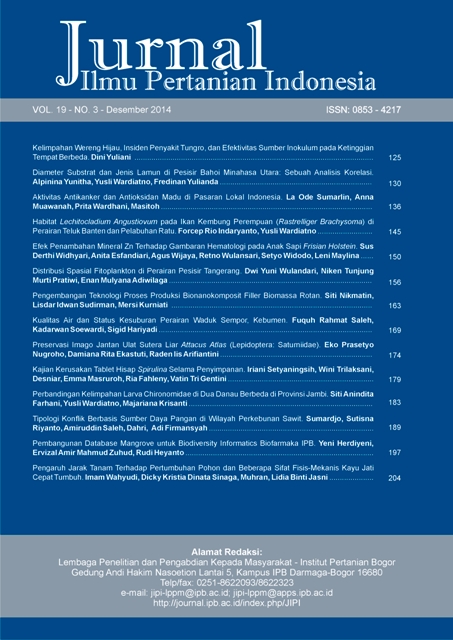Efek Penambahan Mineral Zn Terhadap Gambaran Hematologi pada Anak Sapi Frisian Holstein
Abstract
The objective of this experiment was to determine the effects of zinc supplementation on health status in dairy calves. Nine Frisian Holstein (FH) at 6-10 months of age were used in this experiment and divided into three groups. First group (no added Zn) for control, the second group was added 60 ppm Zn, and the third group was added 120 ppm Zn. Zn was administered daily for three months. Blood samples were collected from the jugular vein and anticoagulated with EDTA. Whole blood were used for measuring erythrocytes, hemoglobin concentration, hematocrit value, total leukocyte count, and leukocyte cell types. The results showed that no difference among groups for hematological parameters and the value of hematology were in the range values references. In conclusion, 60 and 120 ppm Zn supplementation in the feed is relatively safe for health.
Downloads
References
Azizzadeh M, Mohri M, Seifi HA. 2005. Effect of oral zinc supplementation on hematology, serum biochemistry, performance, and health in neonatal dairy calves. Comparative Clinical Pathology. 14(2): 67-71.
Bender AD. 1993. Introduction to Nutrition and Metabolism. UCL Press Limited, University College London, London (GB).
Bires J, Linderova I, Bartko P, Bajova V, Kovarova E. 1992. Change in the phagocytic activity of blood leukocytes in pregnant dairy cows after the administration of Zindep (Zinc preparation). Zivocisna-Vyroba. 37(10): 861-866.
Buckley WT. 2000. Trace Element Dynamics. In: D'Mello JPF, editor. Farm Animal Metabolism and Nutrition. CAB International Publishing, New York (US): 161-182.
Cunningham JG. 2002. Textbook of Veterinary Physiology. Ed ke-3. W.B. Saunders Company, Philadelphia (US).
D’Mello JPF. 2000. Farm Animal Metabolism and Nutrition. CAB International Publishing, New York (US).
Harmon RJ, Torre. 1998. Economic implications of copper and zinc proteinates: Role in mastitis control. In: Lyons TP, Jacques KA, editor. Biotechnology in Feed Industry. Proceedings of Alltech’s 13th Annual Symposium. US: Alltech Technical Publications. 419-430.
Helge K, Rink L. 2003. Zinc-altered immune function. Journal of Nutrition. 133(5): 1452S-1456S.
Jain NC. 1993. Essentials of Veterinary Hematology. Lea and Febiger, Philadelphia (US).
Kawachi H. 2006. Micronutrients affecting adipogenesis in beef cattle. Animal Science Journal. 77(5): 463-471.
King JC. 2000. Determinants of maternal zinc status during pregnancy. American Journal of Clinical Nutrition. 71(5): 1334-1343.
Lieberman S, Bruning N. 1990. The Real Vitamin and Mineral Book. A very publishing group inc garden city park, New York (US).
Meyer DJ, Coles EH, Rich LJ. 2004. Veterinary Laboratory Madicine Interpretation and Diagnosis. WB Saunders Company, Philadelphia, Pennsylvania (US).
Minton JE, Coppinger TR, Reddy PG, Davis WC, Blecha F. 1992. Repeated restraint and isolation stress alters adrenal and lymphocyte functions and some leukocyte differentiation antigens in lamb. Journal of Animal Science. 70(4): 1126-1132.
Mohri M, Sharifi K, Eidi S. 2007. Hematology and serum biochemistry of Holstein dairy calves: age related changes and comparison with blood composition in adults. Journal of Veterinary Science. 83(1): 30-39.
O’Dell BL. 1981. Metabolic Functions of Zinc-A New Look. In: Howell JM, Gawthorne, White CL, editor. Trace Element Metabolism in Man and Animals. TEMA 4. Proceedings. Australia: Australian Academy of Science Canbera.
Pinna K, Darshan SK, Peter CT, Janet CK. 2002. Immune functions are maintained in healthy men with low zinc intake. Journal of Nutrition. 132(7): 2033-2036.
Rink L, Kirchner H. 2000. Zinc-altered immune function and cytokine production. Journal of Nutrition. 130(5): 1407S-1411S.
Salgueiro MJ, Zubillage M, Lysionek A, Cremaschi G, Goldman CG, Caro R, De Paoli T, Hager A, Weill R, Boccio J. 2000. Zinc status and immune system relationship. Biological Trace Element Research. 76(3): 193-205.
Stockholm SL, Scott MA. 2002. Fundamentals of Veterinary Clinical Pathology. 1st ed. Iowa State Press, Iowa (US).
Supriyati D, Haryanto B. 2007. Pengaruh suplementasi Zn-biokompleks dalam ransum terhadap pertumbuhan domba muda. Jurnal Ilmu Ternak dan Veteriner. 12(4): 268-273.
Tanaka S, Takahashi E, Matsui T, Yano H. 2001. Zinc promotes adipocyte differentiation in vitro. Asian – Australasian Journal of Animal Sciences. 14(7): 966-969.
Truong-Tran AQ, Ho LH, Chai F, Zalewki PD. 2000. Cellular zinc fluxes and the regulation of apoptosis/ gene directed cell death. Journal of Nutrition. 130(5): 1459-1466.
Underwood EJ, Suttle NF. 2001. The Mineral Nutrition of Livestock. CABI Publishing, Boston (US).
Widhyari SD. 2005. Patofisiologi sekitar partus pada kambing peranakan etawah; Kajian peran suplementasi zincum terhadap respons imunitas dan produktivitas [Disertasi]. Bogor (ID): Institut Pertanian Bogor.
Widhyari SD, Widodo S, Wibawan IWT, Sutama IK, Esfandiari A. 2011. Profil kadar kortisol dan seng pada kambing peranakan etawah saat melahirkan yang diberi tambahan seng dalam pakannya. Jurnal Veteriner. 12(3): 220-228.
Winarsi H. 2004. Respons hormonal dan imunitas wanita premenopause terhadap minuman fungsional berbahan dasar susu skim yang disuplementasi dengan isoflavon kedelai dan seng [Disertasi]. Bogor (ID): Institut Pertanian Bogor.
This journal is published under the terms of the Creative Commons Attribution-NonCommercial 4.0 International License. Authors who publish with this journal agree to the following terms: Authors retain copyright and grant the journal right of first publication with the work simultaneously licensed under a Creative Commons Attribution-NonCommercial 4.0 International License. Attribution — You must give appropriate credit, provide a link to the license, and indicate if changes were made. You may do so in any reasonable manner, but not in any way that suggests the licensor endorses you or your use. NonCommercial — You may not use the material for commercial purposes.



















